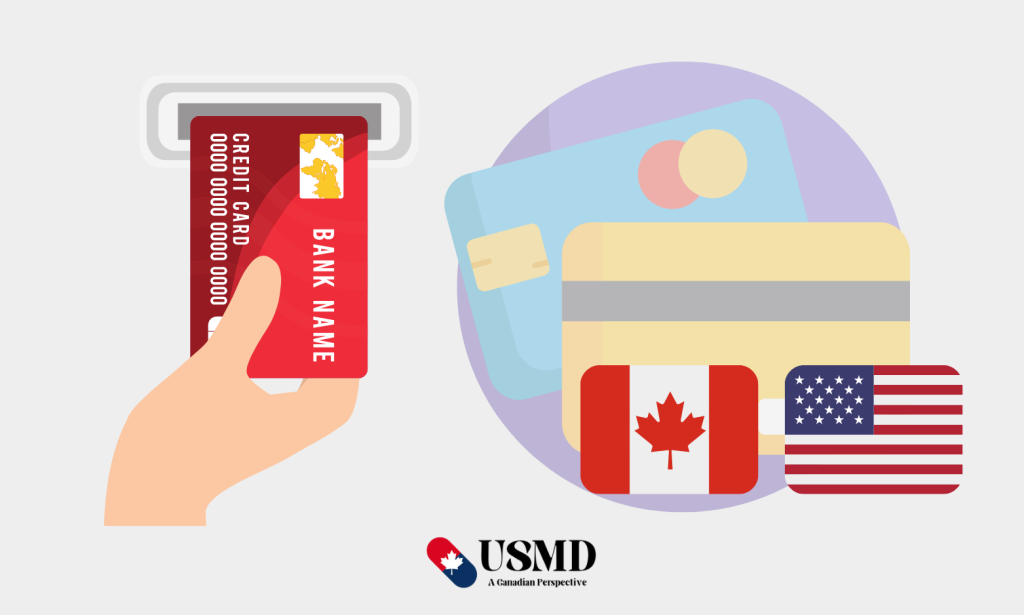
Attending medical school (or a pre-med undergrad) in the United States is expensive, to say the least. Besides tuition, there needs to be money for rent, food, utilities, textbooks and supplies, transportation and leisure. Fortunately, there are many resources available for Canadians to fund these things – from Canadian student loans, medical student lines of credit (LOCs), institutional financial aid and even scholarships.
At the same time, the high cost presents an opportunity to maximize your spending by picking the right credit card. You’re in a unique position of spending quite a bit (and meeting a high welcome bonus) despite having no or low income, and likely looking for ways to travel back home to Canada cheaply at least a few times a year. You can capitalize on money you’ll already be spending and earn points for free trips home, to pay off your statement and more. I earned enough points from my spending in first year to pay for my honeymoon!
A word of warning – there is an investment required (in terms of annual fees) to make the most of your spending.
Can I even get an American Credit Card?
If you’ll be in the United States, you should get an American card – right? Well, it’s not so simple.
The American and Canadian credit bureaus are completely separate, and while you might have a credit file in Canada – you certainly won’t in the United States. At the same time, you won’t have a Social Security Number, and likely won’t have an ITIN (individual taxpayer identification number) either – which is required to apply for an American credit card.
At best, you’ll be eligible for a watered-down, low credit-limit and no-or-low rewards international student card that does absolutely nothing to maximize your (possibly substantial) spending.
Fortunately, there is a way around this – namely, American Express (AMEX).
The AMEX Workaround
AMEX Canada has some of best cards by a few metrics; you can earn a lot of points through high welcome bonuses and earn rates – and the points you earn (Membership Rewards Points) are worth a lot – around 2.2 cents per point if you’re smart about redemptions. In addition, there’s no minimum income for most of their cards – making them a good fit for students.
There are a couple of downsides
- there’s a foreign exchange fee when used in the United States of 2.5% on all of their cards
- many of their cards have high fees
However, for Canadians attending school in the United States, by and far the best feature of being an AMEX cardholder is the “AMEX Workaround” – the fact that you can apply for an American AMEX card using your existing Canadian credit score. This opens the door to some of the best American credit cards to help maximize your spending. It’s important to note that you must already hold a Canadian AMEX before you can apply.
Below, I’ll outline the path I took as a Canadian Medical Student in the United States that reflected my priorities – to maximize signup bonuses from my spending and to prioritize travel home with Air Canada.
Use AMEX & Maximize Earn for Travel
This strategy maximizes welcome bonuses and assumes you’ll want to use points to travel. The downside? High annual fees. We’re working on another article for those students with less spending and perhaps a lower tolerance for fees – check back soon!
Step 1: Apply for The American Express Aeroplan Reserve Card

The AMEX Aeroplan Reserve Card has no minimum income requirement, and has a high welcome bonus – about 85,000 Aeroplan points if you spend $6,000 CAD over the first six months. The card earns Aeroplan points (as you’ve likely guessed) at a rate of 1.25 pts per dollar on most purchases, 2 pts per dollar on dining and food delivery, and 3 pts per dollar on Air Canada purchases.
Aeroplan points are Air Canada’s loyalty program points, and are best redeemed for travel with Air Canada and their many partner airlines. While you can use points to purchase any seat on an Air Canada flight at a dynamic rate, some of the best redemptions are through their partner airlines.
The fee for the card is $599 CAD/yr – but don’t let that scare you too much, as I can almost guarantee that it’s worth it.
Let’s say you spend $8,000 CAD over the first 6 months on things you would’ve purchased anyways – textbooks, food and groceries, furniture, a trip home etc. You would earn about 3000pts ($1000 Air Canada at 3pts/$) + 3000pts ($1500 dining at 2pts/$) + 6875pts ($5500 everything else at 1.25pts/$) + 85,000 pts (welcome bonus) for a total of 97,875pts.
What can you do with ~100k Aeroplan points? A lot!
Aeroplan Worked Example
Let’s pretend you’re going to school in Boston and live in Winnipeg – an often expensive flight. You need to fly home from the 21st to the 25th of March for a family event, and you don’t have an Air Canada Student Flight Pass.
Cash Fare
The cheapest fare is with Air Canada, for $1267 CAD. This fare is a Standard economy fare, and doesn’t include a checked bag – that’ll be another ~$80 CAD.
Points Redemption
What if you used points? Well, for only 50,000 points you can avoid paying that $1267 CAD (less $237 CAD in fees, but still over $1000 CAD less). Oh, and this is in Business Class! Not only does that come with lounge access and meals, but it also comes along with two free checked bags.
Even if you combined the annual fee with the taxes and fees, you would still be getting ~$400 CAD off your trip – and be able to experience business class with all the perks and have 50,000 points left over for a free future trip (or trips if you choose a cheaper economy redemption).
Other Card Benefits
I also haven’t mentioned some of the biggest benefits of the card – the perks that you get when travelling with Air Canada, even in economy class.
To name a just few perks you get when flying with Air Canada:
- Priority Check-In, Boarding and Customer Service
- Unlimited Maple Leaf Lounge Access
- Free Checked Bag
- Priority Baggage Handling
- Excellent travel insurance
As you can see, beyond easily making back the annual fee in free travel – there are also a tonne of other benefits to make trips back home to Canada all the more comfortable.
Step 2: Apply for a US American Express Card with Global Card Transfer
As amazing as the Aeroplan Reserve card is, there are downsides. The biggest is the foreign exchange fee of 2.5% – if you use this card while in the USA, you not only have to pay the exchange rate but also this extra 2.5% fee. With a US card, there would be no such exchange or fee, and you can transfer money at a far more favourable rate to your US bank account to pay off the card.
Now that you have a Canadian American Express card, you can very easily apply for any of the US AMEX cards via the Global Card Transfer program.
I won’t recommend any specific card here, as there are a wide range of cards with different pros and cons. As one example, the American Express Gold Card earns 4X Membership Rewards (MR) points per dollar spent at US grocery stores and restaurants. MR points can be converted 1:1 to Aeroplan or other programs.
In any case, you now have the ability to apply for a premium US credit card with high earn rates, a sizable welcome bonus and many other benefits despite not having an American credit score or credit history.
Perhaps more importantly, you’ll be able to start building your US credit score!
Step 3: Spend with your US American Express Card
Once you’ve hit your welcome bonus with your Canadian AMEX, switch spending to your US card. You won’t have to worry about the extra currency conversion fee and you can start working towards hitting the welcome bonus on your American card. Every month you pay your card, you’ll be building your US credit history.
Conclusion
Attending school in the United States isn’t cheap – and it pays to maximize the points you can earn with all that spending.
Applying for a Canadian American Express card without an income requirement (like the Aeroplan Reserve) will allow you to apply for a US American Express card without a social security number, ITIN or US credit history. You’ll be able to instantly start building your US credit history.
As an added bonus, you’ll save big on travel and can enjoy many other perks – just by spending the money you would have anyways.
Epilogue: An Alternative to the Aeroplan Reserve
While I’m a huge travel fan (specifically a huge Air Canada fan), the $599 fee for your Canadian American Express card is indeed very steep. While it makes sense for most people who can hit the welcome bonus, not everyone will get the same value out of the perks or redeeming Aeroplan points.
As such, I’ll suggest an alternative here – The Cobalt Card.
It’s $12.99 per month and earns 5pts/$ on eats $ drinks, 3pts/$ on streaming subscriptions, 2pts/$ on travel and transit, and 1pt/$ on everything else. It also comes with a 30,000 pt bonus if you spend $500/month for the first year. As a reminder, those MR points can be used to pay off parts of your statement or can be transferred to hotel and airline partners. They can be transferred to Aeroplan at a 1:1 rate.
Plus – you can still use the “AMEX Workaround” strategy to apply for a US card with the Cobalt!

Disclaimer: This is not financial advice, and I have no affiliation with American Express, Aeroplan or any other company mentioned in this post. There are no affiliate links in this post. Only spend what you can, and always pay your cards off in full. I share my own experience and the possibilities available to Canadian students in the USA. Do your own due diligence before making any financial decision.
